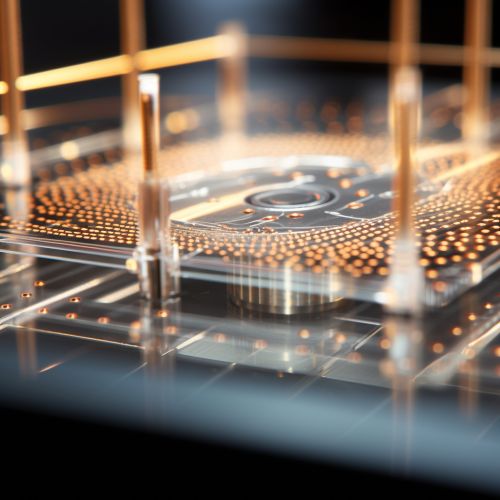Microfluidics
Introduction
Microfluidics is the science and technology of systems that process or manipulate small (10^-9 to 10^-18 liters) amounts of fluids, using channels with dimensions of tens to hundreds of micrometers. The term "Microfluidics" is often associated with the study of behavior, precise control, and manipulation of fluids that are geometrically constrained to a small scale, typically sub-millimeter. It is a multidisciplinary field intersecting engineering, physics, chemistry, biochemistry, nanotechnology, and biotechnology, with practical applications to the design of systems in which low volumes of fluids are processed to achieve multiplexing, automation, and high-throughput screening.
History
The concept of microfluidics was first proposed in the 1950s, with the development of microfabrication technology. However, it was not until the 1990s that the field began to flourish, thanks to advances in microfabrication techniques and the growing interest in nanotechnology. The first microfluidic devices were simple and designed for specific applications, such as the manipulation of DNA molecules. Over time, these devices have evolved to become more complex and versatile, capable of performing a wide range of tasks, from chemical synthesis to biological analysis.


Principles
Microfluidics operates under the principles of fluid dynamics, but at a much smaller scale. At this scale, some interesting and non-intuitive phenomena occur. For instance, flow in microfluidic systems is typically laminar, meaning that different fluid streams can flow side by side without mixing. This is a result of the low Reynolds numbers that characterize microscale flow. Another important principle of microfluidics is the dominance of surface forces over volumetric forces, which can lead to phenomena such as capillary action playing a significant role.
Applications
Microfluidics has a wide range of applications, particularly in the fields of biology and medicine. For example, microfluidic devices are used in the development of lab-on-a-chip technologies, which aim to perform laboratory-scale processes on a single, miniaturized chip. This has the potential to greatly reduce costs and increase efficiency in a variety of areas, including drug discovery, diagnostics, and personalized medicine. Other applications of microfluidics include micro fuel cells, micro heat pipes, inkjet printers, and micro propulsion.
Future Directions
The future of microfluidics looks promising, with ongoing research aimed at developing new materials and fabrication methods, improving device integration, and expanding the range of applications. One area of particular interest is the development of organ-on-a-chip technologies, which aim to replicate the function of human organs on a microfluidic device. This could revolutionize drug testing, reducing the need for animal testing and speeding up the drug discovery process.
